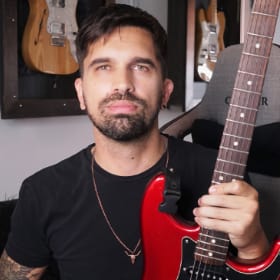More
- Peruvian MarineraLEVEL 3Traditional Peruvian dance.
- Hungarian Minor Scale (Solo)LEVEL 6I composed a solo so you can get ideas, patterns, arpeggios and different things to start approaching this new scale sound.
- Around The WorldLEVEL 4Traditional Caribbean music.
- Around the World - India, Sitar StyleLEVEL 4Fingerpicking style with micro bendings and slides.
- PolynesiaLEVEL 3Polynesian traditional song.
- Around The World: EgyptLEVEL 5Ancient Egyptian music.
- Around The WorldLEVEL 6Serbian traditional dance.
- Celtic BalladLEVEL 3Time for some medieval times celtic acoustic guitar feeling.
- Around the World - ChinaLEVEL 3Traditional Chinese Music
Feedback
 DerW24th June 2013
DerW24th June 2013 GREAT !!!
GREAT !!!  :D:D
:D:D Javier Aviles4th April 2013
Javier Aviles4th April 2013Great mate Sinisa. This video has a lot of work. Congratulations.
 Dieterle2nd April 2013
Dieterle2nd April 2013:-)
 DeGroot1st April 2013
DeGroot1st April 2013This is beyond amazing! Great entertainment and playing.
 Sinisa Cekic31st March 2013
Sinisa Cekic31st March 2013Thanks friends, highly appreciate

sieg66631st March 2013
Brilliant and entertaining. A lot of skill and effort went into this. Thank you.
 St Anger30th March 2013
St Anger30th March 2013Open Mind Sensei !
 Gabriel Leopardi30th March 2013
Gabriel Leopardi30th March 2013Hey Sinisa, this lesson is EPIC. It like a world tour in 10 minutes! I really enjoyed this journey. Thanks a lot! And great job with Argentina.

 Ben Higgins30th March 2013
Ben Higgins30th March 2013Amazing work, S-Master !! Turkey and Egypt are my favourite parts - epic !

 Bogdan Radovic30th March 2013
Bogdan Radovic30th March 2013Amazing lesson - after watching it I really feel like I have been traveling

 MonkeyDAthos30th March 2013
MonkeyDAthos30th March 2013Bravo

 TreyDeschamp29th March 2013
TreyDeschamp29th March 2013Great lesson!
Slavenko Erazer29th March 2013
Awesome lesson.
And at the end- Last, but not least, Serbia
 Sinisa Cekic29th March 2013
Sinisa Cekic29th March 2013Big Thanks guys

 Cosmin Lupu29th March 2013
Cosmin Lupu29th March 2013My sincerest congratulations Sinisa! It was a real pleasure and you have my word I will learn it myself

 Darius Wave29th March 2013
Darius Wave29th March 2013Well Sir...this is something huuuuge!

 Kristofer Dahl29th March 2013
Kristofer Dahl29th March 2013This is BIG! I just felt like have visited 30 countries in ten minutes (or 29 to be precise). This is a fantastic composition Sinisa, thanks again for the inspiration!
- Lesson
- My notes
Hi folks!
The musical heritage of our planet is an inexhaustible treasury!
East, west, north or south - every corner has something unique and yet common. Traditional music is part of a country's cultural heritage, which is connected to the people's history, character and temperament.
In this lesson I have tried to give you a taste of these treasures, waiting to be explored, shaped and adapted.
I recommend listening to World Music as much as you can. You never know what you can discover, and how you can get inspired.
I would like to dedicate this composition to the entire world population, our cultural norms and musical heritage!
Countries covered in this lesson:
1. Japan
2. Ireland
3. Scotland
4. Italy
5. Spain
6. France
7. Austria
8. Portugal
9. Sweden
10. Thailand
11. Turkey
12. Egypt
13. Greece
14. Polynesia
15. USA
16. Kenya
17. Cuba
18. Brazil
19. Argentina
20. Mexico
21. Peru
22. Romania
23. Hungary
24. Russia
25. Macedonia
26. Bulgaria
27. India
28. China
29. Jamaica
30. Serbia
Gear used:
DAW Sonar X1
Ibanez SC 3120 J Custom
Tom Anderson Crowdser
Boss GT 10 guitar processor
Guitar Rig 5
Sound settings:
In this composition I didn't use any midi converter/sample related to the guitar solo and rhythm sections shown in this video.
Getting specific guitar tone depends on the ability and willingness to research to get what you want. Equalizers and filters do wonders by processing dry guitar signal, but what is more important is is to catch the vibe of the instrument you wish to emulate.
In this lesson I will teach you how I approach playing all these different styles and emulating other instruments on the guitar as well as provide you with practical tips in order to make this journey a bit easier for you!
First of all, you should make a plan and approach for each individual style, here is mine:
1. Listen to the traditional music in the certain style
2. Identify the traditional instruments used and typical phrasing of the instrument
3. Find corresponding techniques on guitar which will allow me to emulate the style and phrasing of the traditional instrument
4. Figure out typical scales and chord progressions used in order to compose the backing track
5. Compose the guitar tracks and use clever mixing (usually VST instrument overdubbing guitar parts) to get as close to the given style as possible
Don't forget that you can always contact me through GMC forum or lesson feedback for any questions you might have!
Enjoy!
S.C.
Jump to start: Home or `s` , you can also click/tap the lesson part again (the numbers above player)
Go to next part: PageUP or End.
Volume: ArrowUp / ArrowDown keys
Go to any part: Number keys (combinations also possible)
Pause or play: `k` or space key
Fullscreen: `f`, esc to close
Increase / decrease speed : `+` or `-`








